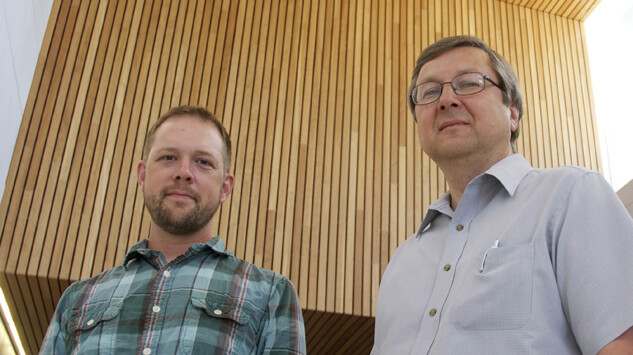
An international team of scientists, including UNL physicists J. D. Burton and Evgeny Tsymbal, has discovered what they called an intriguing and entirely unexpected phenomenon at the surface of a transition metal oxide material.
Such materials serve as a hotbed for electrochemical applications like solid fuel cells and oxygen sensors, as well as potential applications in future electronic devices.
“Our work shows that it’s possible to detect and characterize the smallest features on the surfaces of transition metal oxides, even down to the atomic scale,” said Burton, a research assistant professor of physics. “This could lead to huge advancements in the understanding and control of electronic, magnetic and chemical properties of this important class of materials.”
The findings were reported in the July 24 issue of Nature Communications, the Nature Publishing Group’s multidisciplinary online journal of research in all areas of the biological, physical and chemical sciences.
The discovery is based on scanning tunneling microscopy, or STM, of samples prepared and measured at Oak Ridge National Laboratory in Tennessee. Using atomic scale STM measurements, researchers were able to map out the precise positions of oxygen atoms on the surface of this transition metal oxide. Surprisingly, it was found that oxygen atoms not only order in a regular array of sites, but superimposed on this regular array was a subtle zig-zag like pattern of distortions.
The nature of this zig-zag-like phenomenon was first unclear to the scientists, but Burton and Tsymbal were able to discover the explanation by modeling the atomic structure and electronic properties of the material surface through computations at UNL’s Holland Computing Center. Results indicated that changes in the electronic structure of the surface due to the presence of extra oxygen atoms led to a subtle structural transformation of the material just below the surface.
“Crucially, our computations and analysis were decisive for the understanding of the origin of this phenomenon,” Burton said. “We were able to elucidate the microscopic mechanism responsible for this exciting discovery.”
Collaborative research on complex oxide materials is one of the constituents of UNL’s Materials Research Science and Engineering Center supported by the National Science Foundation.
“This remarkable finding shows the deep underlying physics controlling properties of these materials,” said Tsymbal, George Holmes Professor of Physics and director of the center. “It also demonstrates the critical importance of collaborations between experimentalists and theorists in elucidating new phenomena.”
It’s the seventh time in last four years that research from Tsymbal’s group has been published in of the highest-impact interdisciplinary journals such as Science, the Proceedings of the National Academy of Sciences, and Nature Publishing Group.
A native of Columbus and a graduate of Columbus High School, Burton earned his bachelor’s (2003), master’s (2006) and doctoral (2008) degrees in physics at UNL.







